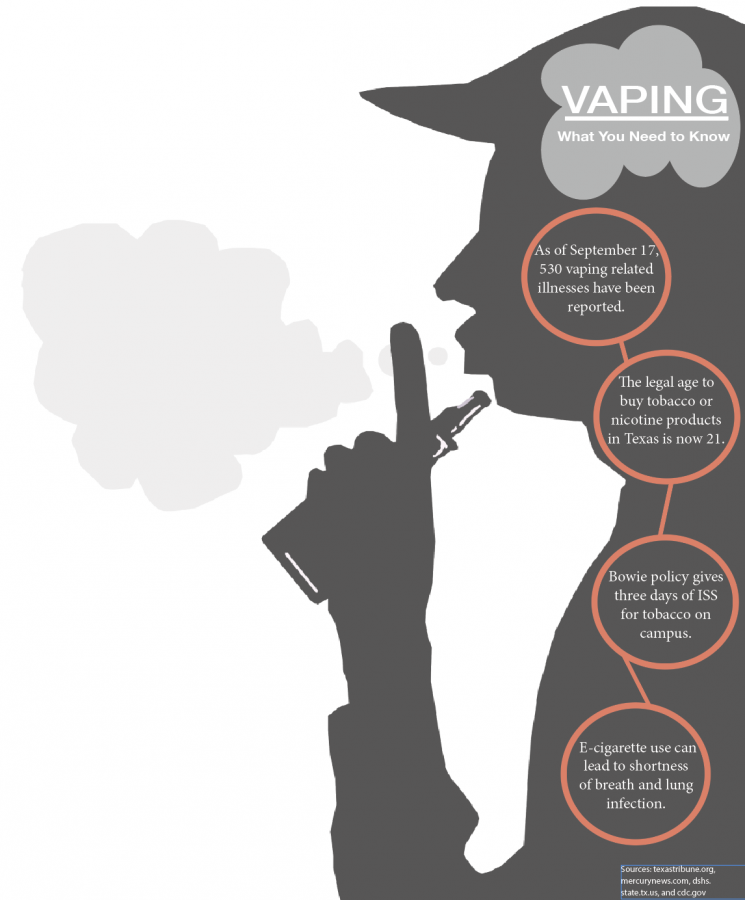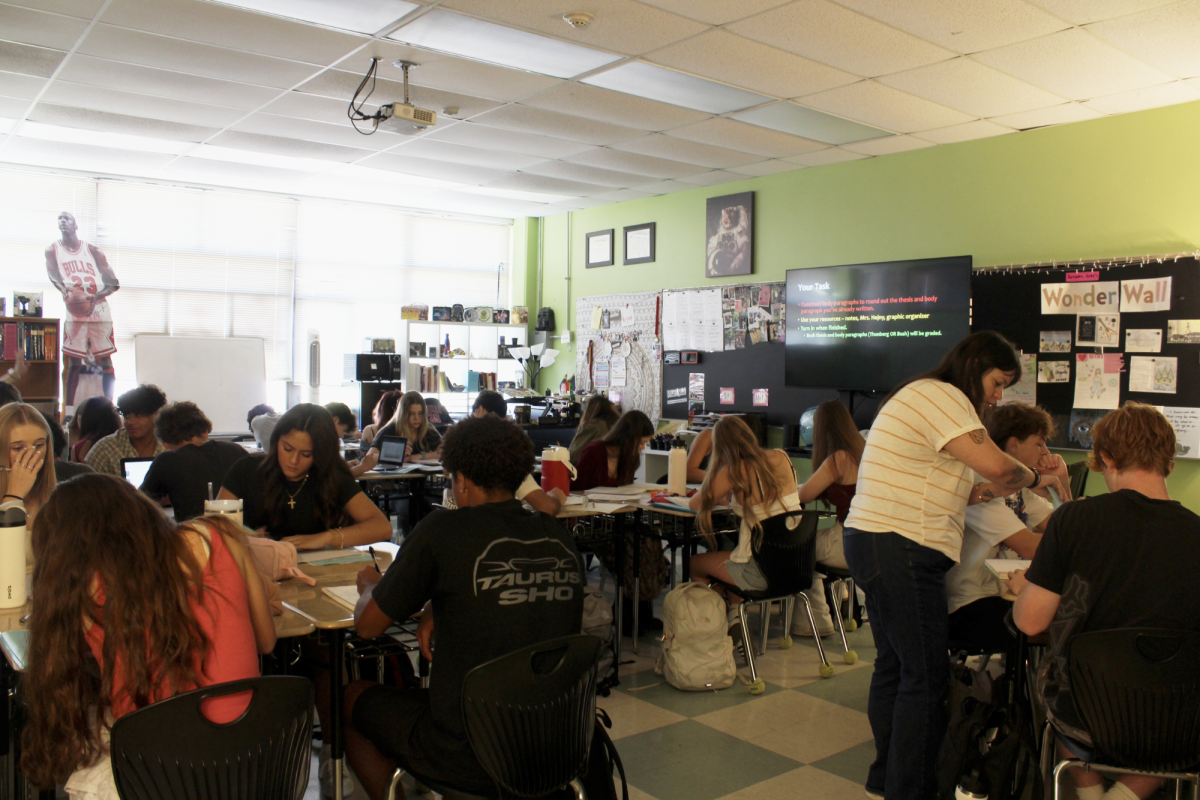The stewing storm of sweet smoke
A figure exhales after using an e-cigarette. Facts are presented with the most important thing to know about vaping and Bowie/s policy on the matter.
October 8, 2019
A teenage boy hides away in a bathroom stall as he slowly takes a small device from his pocket. Lifting the e-cigarette to his mouth, the boy inhales a puff of smoke. As he exhales, a light haze of sweet vapor fills the room. This very scene has become commonplace in high schools across the nation.
As of September 1 in the state of Texas, the legal age to buy tobacco and nicotine products, including e-cigarettes, is 21.
“It was like sophomore year with just like everybody that was in our grade was doing it,” senior Ben Satler* said. “Everybody kind of just kept doing it until they got hooked on it, and now I know kids that are actually addicted to it.”
According to the Campaign for Tobacco-Free Kids, 19% of high schoolers in Texas use or have used e-cigarettes.
“I distinctly remember two years ago, it [popped] up on the scene,” Biology and anatomy/physiology teacher Jessica Davis said. “I remember because, well, there was a rumor that it would happen in the bathroom.”
Despite what commercial advertisements may display, when the battery of the e-cigarette heats up the liquid to produce smoke, it releases aerosol into the lungs, not water vapor.
“When I first started, it was like it’s just, it’s a better alternative to smoking, and people have been smoking for 60 plus years,” Satler said, “Then I started looking it up and like popcorn lungs, and all this started coming up, and I was like, do I really want to mess up my lungs at 15 years old?”
“Popcorn-lung” or bronchiolitis obliterans, as described by the Texas Department of Health Services, is caused by a chemical in vape flavoring called Diacetyl.
“I knew there were always health problems associated with vaping, but now I realize it is worse than I thought,” junior David Ronald* said. “[It] scares me for the kids that did it not knowing the problems.”
Popcorn lung occurs when Diacetyl scars tiny air sacs in the lungs, and symptoms of wheezing and shortness of breath can appear, according to the DSHS.
“My science brain was a little skeptical because I had a very tough time believing that it was a safe alternative to cigarettes,” Davis said. “The combination of it being a hot liquid pulled into your lungs, which your lung tissue is always very vulnerable, with thousands of chemicals present just can’t be a good thing.”
As released by the Center for Disease Control and Prevention, 530 cases of lung injuries connected to e-cigarettes have been reported as of September 17.
“I feel like most of the kids that are probably getting these illnesses from vaping could have also come from like illegal THC [tetrahydrocannabinol] cards,” Satler said. “Those have no regulations on them where these kids are, and they could be smoking pesticides for all they know.”
The CDC has also released that 16% of the illnesses reported are in youth under 18 years of age.
“I think people just want to be accepted by others and they think it’s some kind of social status boost when they [smoke],” Ronald said. “People also vape because they don’t want to do drugs, but they still want some kind of title similar to that.”
As reports of vaping-related illnesses increase, the exact cause of lung symptoms has yet to be determined.
“I’ve had the debate with my own kids in this perception that it’s a safer alternative to cigarettes, that it’s just vapor,” Principal Mark Robinson said. “That debate has made me aware of some of the misconceptions, and as a principal and a parent, I connect with this issue in a meaningful way.”
In response to the spike in lung conditions connected to e-cigarette use, the Food and Drug Administration is drafting a national ban on flavored pods.
“I think [a ban] may have an impact at the youngest ages, the middle schoolers and high schoolers that are trying it,” Davis said. “I would love to see even more regulation by increasing the tax on it so that is becomes cost-prohibitive for younger people.”
In addition to new state-wide policies, Robinson explained that Bowie has adjusted its vaping policy to meet the urgency of the situation.
“I feel like this is like a lot of the other problems that the schools are asked to solve, but it can’t just be all the schools to solve,” Robinson said. “We’re going to continue to be vocal and educate our students about the dangers of vaping because it’s our current reality.”
Within the new policy, a student can now receive three days of ISS for a first-time tobacco offense.
“I didn’t let nicotine control me, and I stay on task with my stuff,” Satler said. “If it’s really controlling someone’s life outside of school, that means that they have another major problem to deal with.”
Despite an increased presence of teachers in hallways during passing periods and lunches, it can be difficult to control e-cigarette use in the bathroom.
“I’m not surprised kids are drawn to it,” Davis said. “I just hope that they understand that they are hurting themselves.”
Despite the prominence of vaping on campus, Bowie is officially a no-tobacco campus, meaning e-cigarettes should not be brought to school.
“We already know smoking is bad for you, but we’ve seen this just spread like a wildfire,” Robinson said. “I would hope that anyone who reads this article would think twice and ask, do I really need to do this?”









